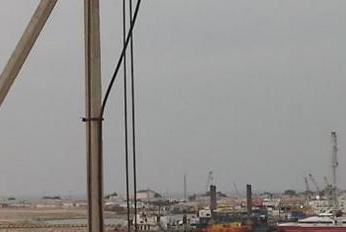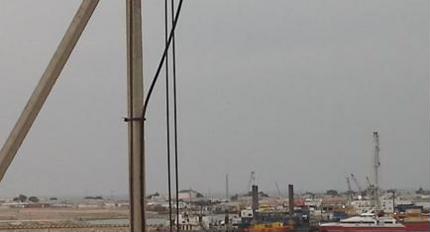Documents
This section features public documents and files uploaded by the stakeholders and custodians of the Caspian Sea environment.
 Second National Communication to the United Nations Framework Convention on Climate ChangeFri, 20/04/2018 - 15:18The document represents the second national report of the Republic of Azerbaijan on the implementation of the United Nations Framework Convention on Climate Change. It presents national situational analysis, information on emissions and removals of greenhouse gases (GHGs), overview the activities Azerbaijan undertakes to imp
Second National Communication to the United Nations Framework Convention on Climate ChangeFri, 20/04/2018 - 15:18The document represents the second national report of the Republic of Azerbaijan on the implementation of the United Nations Framework Convention on Climate Change. It presents national situational analysis, information on emissions and removals of greenhouse gases (GHGs), overview the activities Azerbaijan undertakes to imp- Description
The document represents the second national report of the Republic of Azerbaijan on the implementation of the United Nations Framework Convention on Climate Change. It presents national situational analysis, information on emissions and removals of greenhouse gases (GHGs), overview the activities Azerbaijan undertakes to implement the Convention, assessment of vulnerability to climate change, and calls for adaptation measures.
The document is published within the framework of the joint project of the Government of Azerbaijan and United Nations Development Programme "Enabling Activities for the Preparation of Azerbaiijan's Second National Communication to the UNFCCC" with the financial support of the Global Environmantal Facility (GEF).
- Attached documents
- Metadata
- Year
- 2010
 Final Report: Caspian Sea POPs Workshop (2010)Fri, 20/04/2018 - 15:05The Tauw Consortium (TC) formed by Tauw bv - the Netherlands, Milieukontakt International (MKI) - the Netherlands, International HCH and Pesticides Association (IHPA) - Denmark and COWI A/S - Denmark, was selected by the World Bank in October 2009 to execute a Caspian regional POPs workshop in Azerbaijan. TC forms a strong O
Final Report: Caspian Sea POPs Workshop (2010)Fri, 20/04/2018 - 15:05The Tauw Consortium (TC) formed by Tauw bv - the Netherlands, Milieukontakt International (MKI) - the Netherlands, International HCH and Pesticides Association (IHPA) - Denmark and COWI A/S - Denmark, was selected by the World Bank in October 2009 to execute a Caspian regional POPs workshop in Azerbaijan. TC forms a strong O- Description
The Tauw Consortium (TC) formed by Tauw bv - the Netherlands, Milieukontakt International (MKI) - the Netherlands, International HCH and Pesticides Association (IHPA) - Denmark and COWI A/S - Denmark, was selected by the World Bank in October 2009 to execute a Caspian regional POPs workshop in Azerbaijan. TC forms a strong OP, POP and hazardous chemicals team that has cooperated in different combinations in many projects in Central Asia and the Caucasus. Local partner was Mr. Islam Muslim Mustafayev the director of the Azerbaijan branch of the Caucasus Environmental NGO Network.
The workshop aiming at the improvement of obsolete pesticides management was held at the World Bank Office in Baku, from 7 till 11 December 2009 with participants from the five Caspian littoral states and donor organizations (World Bank, FAO). The workshop comprised sessions on: - An update on implementation of international requirements related to obsolete/ POPs pesticides - Development and strengthening of legal and institutional framework - Public awareness raising - Technical problems and priorities The workshop was held as an interactive workshop in which participants presented the current state of the abovementioned aspects of pesticide management for their country. Difficulties and gaps were discussed and ideas were developed in order to bridge the gaps identified. A legal gap analysis showed that in all countries there are gaps in legislation concerning the pesticides cycle. POPs often are not included and legislation needs to be aligned with international requirements. There is a lack of coordination between institutions and stakeholders in most countries. In many countries environmental and human health problems related to obsolete pesticide stocks are aggravated by a lack of awareness. Russia and Azerbaijan presented their experiences with inventory and technical difficulties. The presentations showed that there are problems with planning and coordination, a lack of environmentally sound storage capacity, a lack of knowledge concerning the scale of the problem (reliable and complete national inventory) and a lack of knowledge concerning handling of liquid pesticides. Action plans were presented, which for some countries like Russia, were plans of different options (signing the convention, detailed inventory, pilot on implementation PSMS). Also for Turkmenistan, ratification of the Stockholm Convention is a big challenge. For other countries like Azerbaijan, there is a follow up project about to start. Therefore the action plan for Azerbaijan comprises a number of defined steps already (capacity building, full national inventory). Iran presented an action plan for repackaging of obsolete pesticides in the Golestan province.
- Attached documents
- Metadata
- Year
- 2010
 Technical Services for Pesticides Inventories, Feasibility Study and Materials Disposal for Azerbaijan (Tauw) (2010)Mon, 16/04/2018 - 16:08This project aimed at inventory training for 10-15 people, mainly from the four Ministries with a designated role in the management of obsolete pesticide stocks (MoA, MoE, MoEm, MoH). The training comprised training on the inventory process, health and safety during inventory, management of inventory data with PSMS, differen
Technical Services for Pesticides Inventories, Feasibility Study and Materials Disposal for Azerbaijan (Tauw) (2010)Mon, 16/04/2018 - 16:08This project aimed at inventory training for 10-15 people, mainly from the four Ministries with a designated role in the management of obsolete pesticide stocks (MoA, MoE, MoEm, MoH). The training comprised training on the inventory process, health and safety during inventory, management of inventory data with PSMS, differen- Description
This project aimed at inventory training for 10-15 people, mainly from the four Ministries with a designated role in the management of obsolete pesticide stocks (MoA, MoE, MoEm, MoH). The training comprised training on the inventory process, health and safety during inventory, management of inventory data with PSMS, different approaches for stores and burial sites and on the job inventory training (practical part). The practical training was performed on sites of five former pesticide stores including one site where pesticides were buried and soil and groundwater sampling was trained. This World Bank project will be followed on by a TCP project approved by FAO regarding capacity building in pesticide management in Azerbaijan. The TCP project aims at (amongst others) a full national inventory, risk quantification and action plans for high risk sites. For repackaging, there is no project approved yet. In the evaluation of the training, the trainees were confident to be able to train others in order to perform a full national inventory. Further assistance might be needed on selected topics. The trainees did not see a problem concerning knowledge transfer. It is recommended to select trainees more carefully in the future. Ideally, the participants of the inventory training are the people doing the inventory and to keep all steps of the pesticide stockpile management cycle in mind during the individual steps in order to have funding for the following steps like repackaging, safeguarding and final disposal or destruction.
- Metadata
- Year
- 2010
 Chirag Environmental Survey 2010 Akvamiljø Caspian 10504Mon, 16/04/2018 - 15:37Sampling was conducted from the vessel Svetlomor 2 by personnel from AmC, the Ministry of Ecology and Natural Resources (MENR) and SOCAR. Sediment samples for physical and chemical analysis consisted of 2 replicates, while 3 replicates were taken for biological analyses. Analyses were carried out at AmC Caspian Environmental+6
Chirag Environmental Survey 2010 Akvamiljø Caspian 10504Mon, 16/04/2018 - 15:37Sampling was conducted from the vessel Svetlomor 2 by personnel from AmC, the Ministry of Ecology and Natural Resources (MENR) and SOCAR. Sediment samples for physical and chemical analysis consisted of 2 replicates, while 3 replicates were taken for biological analyses. Analyses were carried out at AmC Caspian Environmental+6
- Description
Sampling was conducted from the vessel Svetlomor 2 by personnel from AmC, the Ministry of Ecology and Natural Resources (MENR) and SOCAR. Sediment samples for physical and chemical analysis consisted of 2 replicates, while 3 replicates were taken for biological analyses. Analyses were carried out at AmC Caspian Environmental Laboratory.
The sediment characteristics and metal concentrations around Chirag were found to be highly variable within and between stations, with generally little change being observed from 2008. Despite the detection footprint remaining unchanged from previous years, LAO concentrations continue to reduce. THC and PAH concentrations were generally low, with the highest concentrations being recorded at stations directly to the northeast of the platform.
Ba concentrations were highest within the LAO contamination footprint, suggesting the higher concentrations to be the result of historical drilling discharges. As observed on previous years the concentration of Cd was also highest within this area. The LAO and Ba footprint, indicating the extent of contamination from platform drilling discharges was found to extend 1250m NE, 500m N, 750m E, 1000m W and 250m S of the Chirag platform position.
The 2010 macrobenthic community was numerically dominated by polychaetes and amphipods.
Abundance and species richness were highest at stations on the periphery of the survey area and decreased towards the platform. The lowest abundance an taxonomic richness were found at stations within the LAO and Ba footprint, with the sparsest communities being present at stations directly to the northeast of the platform. Despite a continual reduction in hydrocarbon concentrations from 2006, a general reduction in abundance and taxonomic richness has been observed at the Chirag survey area from 2000 to 2008. This negative trend has reversed in 2010, with a survey wide increase in annelid abundance and amphipod abundance and taxonomic richness being observed. No distinct change in the physicochemical characteristics has been observed between 2008 and 2010 that can be attributed to the abrupt reversal of these trends.
No additional physicochemical impacts from operational activities have been observed between 2008 and 2010 and in general contamination levels continue to reduce
- Attached documents
- Metadata
- Year
- 2010
Document
Second National Communication to the United Nations Framework Convention on Climate Change
Document
Final Report: Caspian Sea POPs Workshop (2010)
Document
Technical Services for Pesticides Inventories, Feasibility Study and Materials Disposal for Azerbaijan (Tauw) (2010)
Document

